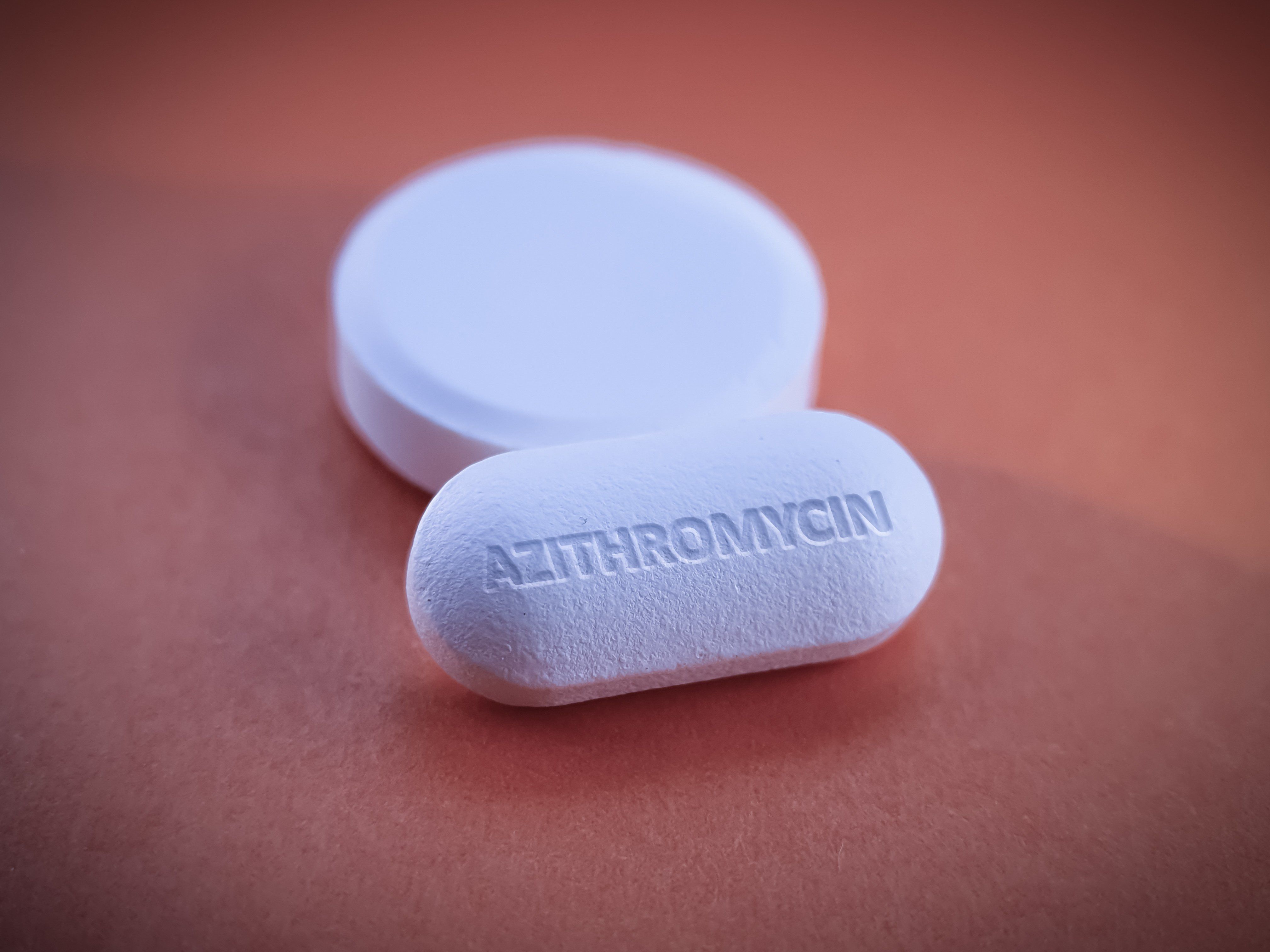Can azithromycin treat COVID-19?


Macrolide antibiotics such as azithromycin have been used for lower respiratory infections and pneumonia, as well as asthma, bronchiolitis, and COPD. Azithromycin dosing is less frequent with a gentler side effect profile than erythromycin and is often used in patients suffering from chest congestion, coughing, increased sputum production, and breathlessness.
Related: What the COVID-19 relief package means for ODs
Since President Donald Trump’s announcement that this drug may be used for COVID-19 treatment, many are asking why an antibiotic would be used to treat a viral infection.
What do ODs need to know about this medication?
Related: One OD weighs in during office closure
About azithromycin
Azithromycin is a macrolide antibiotic with a 15-membered lactone ring. It has excellent tissue penetration and antimicrobial activity against a broad range of Gram-positive and Gram-negative bacteria. Anti-inflammatory effects include reduction in proinflammatory cytokine production1 and hastening of the macrophages phagocytosis ability.2 Direct antiviral actions have been reported.3 Due to its antibacterial and anti-inflammatory effects, it is used for many chronic lung diseases including chronic obstructive pulmonary disease (COPD), asthma, interstitial lung diseases, bronchiectasis, and cystic fibrosis.4
Diffuse panbronchiolitis (DPB) is a chronic, idiopathic inflammatory disease of the bronchioles commonly treated using macrolides. Erythromycin has been shown to significantly reduce levels of IL-8 and human defensins in bronchoalveolar lavage fluid.5 Erythromycin, azithromycin and clarithromycin have been found to inhibit mucus secretion6 and may reduce fluid production by blocking chloride secretion inside epithelial cells in the lungs. Azithromycin in particular was found to protect against bacterial virulence by decreasing Pseudomonas aeruginosa biofilm.7 These patients often suffer from co-infections of Pseudomonas aeruginosa, Haemophilus influenza, and Streptococcus pneumoniae.
In one study of 29 patients with DPB, azithromycin therapy resolved Haemophilus influenza and S. pneumoniae while low levels of Pseudomonas aeruginosa were still detected.8 A dosage of 500 mg per day reversed small airway lesions, improved small airway stenosis, and decreased airway resistance.8
Related: Eyecare industry comes together in COVID-19 virtual town hall
Azithromycin has been shown to improve lung function in patients suffering from cystic fibrosis with pseudomonas infection, but the mechanism is not fully understood. It does not kill Pseudomonas bacteria. Azithromycin may reduce bacteria’s ability to attach to lung lining, or it may reduce bacteria's production of substances damaging to lungs of patients with cystic fibrosis.9
Studies of patients with idiopathic pulmonary fibrosis (IPF), a chronic fatal lung disease causing dyspnea and cough, found azithromycin to be beneficial.10,11 In this disorder, epithelial cells initiate fibrosis of the alveolar lining. Injury of the alveolar epithelial lining followed by aberrant wound healing is believed to be the initiating event for IPF development. Autophagy, the cellular process where damaged organelles, denatured proteins, and other metabolic garbage is disposed of through a lysosomal degradation pathway, malfunctions in IPF. Insufficient autophagy may contribute to fibrogenesis and promote fibroblast activation and extracellular matrix production, stiffening airways making breathing difficult.
Related: ARBO loosens rules on online CE during COVID-19 pandemic
Virus treatment
Because symptoms similar to those in these lung infections are noted with SARS-COV-2 infections, it is not surprising that azithromycin treatment was initiated early in the current pandemic of COVID-19.
Azithromycin has been used against Zika12,13 and Ebola viruses.14
Its use in 25 of 138 patients was reported in a recent JAMA article, “Clinical Characteristics of 138 Hospitalized Patients With 2019 Novel Coronavirus-Infected Pneumonia in Wuhan, China.”15
It has been previously used to treat Middle East Respiratory syndrome, however, its use was not found to be significantly beneficial.16 A popularly referenced study in France found that patients taking both azithromycin and hydroxychloroquine responded better than those treated using hydroxychloroquine alone. Conclusions must be guarded as this was a small study.17
Related: Eyecare practitioners urged to provide emergency care only amid COVD-19
Adverse events
While treatment of lung disease using azithromycin appears promising, it is important to check for a few things before prescribing this drug.
Common side effects include gastrointestinal upset (abdominal pain, diarrhea, constipation, nausea), dizziness, headaches, photosensitivity, or a skin rash.18 Tinnitis and even hearing loss is associated with this medication,19,20 so the medication should be stopped if ringing in the ears is noted. It should be avoided in patients with a history of Stevens-Johnson Syndrome21 and other serious skin reactions,22 as well as those with myasthenia gravis. Development of Clostridium difficile-associated diarrhea has been reported.24
Related: How ODs are addressing COVID-19 in their practices
Prolonged cardiac repolarization and prolongation of the QT interval can occur.25 An electrocardiogram (ECG) should be performed to assess the normal heart rhythm because the medication can cause arrythmias. Patients with abnormal QT intervals, congenital long QT syndrome, a history of torsades de pointes, bradyarrhythmias, or heart failure may be at risk for fatal QT prolongation.26 Elderly patients are more at risk.
Abnormal liver function tests, hepatitis, hepatic necrosis, cholestatic jaundice, and hepatic failure have been reported with its use.27
I generally prescribe this using my electronic prescription service to ensure I do not miss a drug interaction. Azithromycin increased levels of theophylline and aminophylline, warfarin, digoxin, phenytoin, and statins. Nelfinavir increases serum concentration of azithromycin, so those receiving single oral doses need to have liver enzyme tests and hearing monitored.
Finally, chronic use may lead to increased bacterial resistance.4
Related: COVID-19 and contact lens wear: What ODs and patients need to know
References:
1. Altenburg J, de Graaff CS, Stienstra Y, Sloos JH, van Haren EH, Koppers RJ, van der Werf TS, Boersma WG. Effect of azithromycin maintenance treatment on infectious exacerbations among patients with non-cystic fibrosis bronchiectasis: the BAT randomized controlled trial. JAMA. 2013 Mar 27;309(12):1251-9.
2. Feola DJ, Garvy BA, Cory TJ, Birket SE, Hoy H, Hayes D Jr, Murphy BS. Azithromycin alters macrophage phenotype and pulmonary compartmentalization during lung infection with Pseudomonas. Antimicrob Agents Chemother. 2010 Jun;54(6):2437-47.
3. Gielen V, Johnston SL, Edwards MR. Azithromycin induces anti-viral responses in bronchial epithelial cells. Eur Respir J. 2010 Sep;36(3):646-54.
4. Li H, Liu DH, Chen LL, Zhao Q, Yu YZ, Ding JJ, Miao LY, Xiao YL, Cai HR, Zhang DP, Guo YB, Xie CM. Meta-analysis of the adverse effects of long-term azithromycin use in patients with chronic lung diseases. Antimicrob Agents Chemother. 2014;58(1):511–517.
5. Hiratsuka T, Mukae H, Iiboshi H, Ashitani J, Nabeshima K, Minematsu T, Chino N, Ihi T, Kohno S, Nakazato M. Increased concentrations of human beta-defensins in plasma and bronchoalveolar lavage fluid of patients with diffuse panbronchiolitis. Thorax. 2003 May;58(5):425-30.
6. Shimizu T, Shimizu S, Hattori R, Gabazza EC, Majima Y. In vivo and in vitro effects of macrolide antibiotics on mucus secretion in airway epithelial cells. Am J Respir Crit Care Med. 2003 Sep 1;168(5):581-7.
7. Aghai ZH, Kode A, Saslow JG, Nakhla T, Farhath S, Stahl GE, Eydelman R, Strande L, Leone P, Rahman I. Azithromycin suppresses activation of nuclear factor-kappa B and synthesis of pro-inflammatory cytokines in tracheal aspirate cells from premature infants. Pediatr Res. 2007 Oct; 62(4):483-8.
8. Hui D, Yan F, Chen RH. The effects of azithromycin on patients with diffuse panbronchiolitis: a retrospective study of 29 cases. J Thorac Dis. 2013 Oct;5(5):613-617.
9. Saiman L, Marshall BC, Mayer-Hamblett N, Burns JL, Quittner AL, Cibene DA, Coquillette S, Fieberg AY, Accurso FJ, Campbell PW 3rd; Macrolide Study Group. Azithromycin in patients with cystic fibrosis chronically infected with Pseudomonas aeruginosa: a randomized controlled trial. JAMA. 2003 Oct 1;290(13):1749-1756.
10. Krempaska K, Barnowski S, Gavini J, et al. Azithromycin has enhanced effects on lung fibroblasts from idiopathic pulmonary fibrosis (IPF) patients compared to controls [corrected]. Respir Res. 2020 Jan 15;21(1):25.
11. Kawamura K, Ichikado K, Yasuda Y, Anan K, Suga M. Azithromycin for idiopathic acute exacerbation of idiopathic pulmonary fibrosis: a retrospective single-center study. BMC Pulm Med. 2017 Jun 19;17(1):94.
12. Bosseboeuf E, Aubry M, Nhan T, de Pina, JJ, Rolain JM, Raoult D, Musso D. Azithromycin inhibits the replication of Zika virus. J Antivirals Antiretrovirals. 2018 Jan;10(1):6-11.
13. Retallack H, Di Lullo E, Arias C, Knopp KA, Laurie MT, Sandoval-Espinosa C, Mancia Leon WR, Krencik R, Ullian EM, Spatazza J, Pollen AA, Mandel-Brehm C, Nowakowski TJ, Kriegstein AR, DeRisi JL. Zika virus cell tropism in the developing human brain and inhibition by azithromycin. Proc Natl Acad Sci USA. 2016 Dec 13;113(50):14408-14413.
14. Madrid PB, Panchal RG, Warren TK, Shurtleff AC, Endsley AN, Green CE, Kolokoltsov A, Davey R, Manger ID, Gilfillan L, Bavari S, Tanga MJ. Evaluation of Ebola Virus Inhibitors for Drug Repurposing. ACS Infect Dis. 2015 Jul 10;1(7):317-26.
15. Wang D, Hu B, Hu C, Zhu F, Liu X, Zhang J, Wang B, Xiang H, Cheng Z, Xiong Y, Zhao Y, Li Y, Wang X, Peng Z. Clinical Characteristics of 138 Hospitalized Patients With 2019 Novel Coronavirus-Infected Pneumonia in Wuhan, China. JAMA. 2020 Feb 7. doi: 10.1001/jama.2020.1585.
16. Arabi YM, Deeb AM, Al-Hameed F, Mandourah Y, Almekhlafi GA, Sindi AA, Al-Omari A, Shalhoub S, Mady A, Alraddadi B, Almotairi A, Al Khatib K, Abdulmomen A, Qushmaq I, Solaiman O, Al-Aithan AM, Al-Raddadi R, Ragab A, Al Harthy A, Kharaba A, Jose J, Dabbagh T, Fowler RA, Balkhy HH, Merson L, Hayden FG; Saudi Critical Care Trials group. Macrolides in critically ill patients with Middle East Respiratory Syndrome. Int J Infect Dis. 2019 Apr;81:184-190.
17. Gautret P, Lagier JC, Parola P, Hoang VT, Meddeb L, Mailhe M, Doudier B, Courjon J, Giordanengo V, Vieira VE, Dupont HT, Honoré S, Colson P, Chabrière E, La Scola B, Rolain JM, Brouqui P, Raoult D. Hydroxychloroquine and azithromycin as a treatment of COVIDâ19: results of an openâlabel nonârandomized clinical trial. Int J Antimicrob Agents. 2020 Mar 20:105949. doi: 10.1016/j.ijantimicag.2020.105949. [Epub ahead of print]
18. Azithromycin Side Effects. https://www.drugs.com/sfx/azithromycin-side-effects.html. Jun 7, 2019. Accessed 3/27/2020.
19. Mick P, Westerberg BD. Sensorineural hearing loss as a probable serious adverse drug reaction associated with low-dose oral azithromycin. J Otolaryngol. 2007 Oct;36(5):257-63.
20. Ress BD, Gross EM. Irreversible Sensorineural Hearing Loss as a Result of Azithromycin Ototoxicity: A Case Report. Irreversible sensorineural hearing loss as a result of azithromycin ototoxicity. A case report. Ann Otol Rhinol Laryngol. 2000 Apr;109(4):435-7.
21. BrkljaciÄ N, Gracin S, Prkacin I, Sabljar-MatovinoviÄ M, Mrzljak A, Nemet Z. Stevens-Johnson syndrome as an unusual adverse effect of azithromycin. Acta Dermatovenerol Croat. 2006;14(1):40-5.
22. Banerjee I, Mondal S, Sen S, Tripathi SK, Banerjee G. Azithromycin-induced rash in a patient of infectious mononucleosis - a case report with review of literature. J Clin Diagn Res. 2014 Aug;8(8):HD01-2.
23. Herishanu Y, Taustein I. The electromyographic changes induced by antibiotics. A preliminary study. Confin Neurol. 1971;33(1):41-45.
24. Oyaro MO, Plants-Paris K, Bishoff D, Malonza P, Gontier CS, DuPont HL, Darkoh C. High rate of Clostridium difficile among young adults presenting with diarrhea at two hospitals in Kenya. Int J Infect Dis. 2018 Sep;74:24-28.
25. Gibson PG, Yang IA, Upham JW, Reynolds PN, Hodge S, James AL, Jenkins C, Peters MJ, Marks GB, Baraket M, Powell H, Taylor SL, Leong LEX, Rogers GB, Simpson JL. Effect of azithromycin on asthma exacerbations and quality of life in adults with persistent uncontrolled asthma (AMAZES): a randomised, double-blind, placebo-controlled trial. Lancet. 2017 Aug 12; 390(10095):659-668.
26. Lu ZK, Yuan J, Li M, Sutton SS, Rao GA, Jacob S, Bennett CL. Cardiac risks associated with antibiotics: azithromycin and levofloxacin. Expert Opin Drug Saf. 2015 Feb;14(2):295–303.
27. Bethesda (MD): National Institute of Diabetes and Digestive and Kidney Diseases; 2012-. LiverTox: Clinical and Research Information on Drug-Induced Liver Injury [Internet]. Available at: https://www.ncbi.nlm.nih.gov/books/NBK548434/. Accessed 3/27/20.
Newsletter
Want more insights like this? Subscribe to Optometry Times and get clinical pearls and practice tips delivered straight to your inbox.